technical data SKODA FABIA 2008 2.G / 5J Service Manual
[x] Cancel search | Manufacturer: SKODA, Model Year: 2008, Model line: FABIA, Model: SKODA FABIA 2008 2.G / 5JPages: 252, PDF Size: 40.88 MB
Page 84 of 252
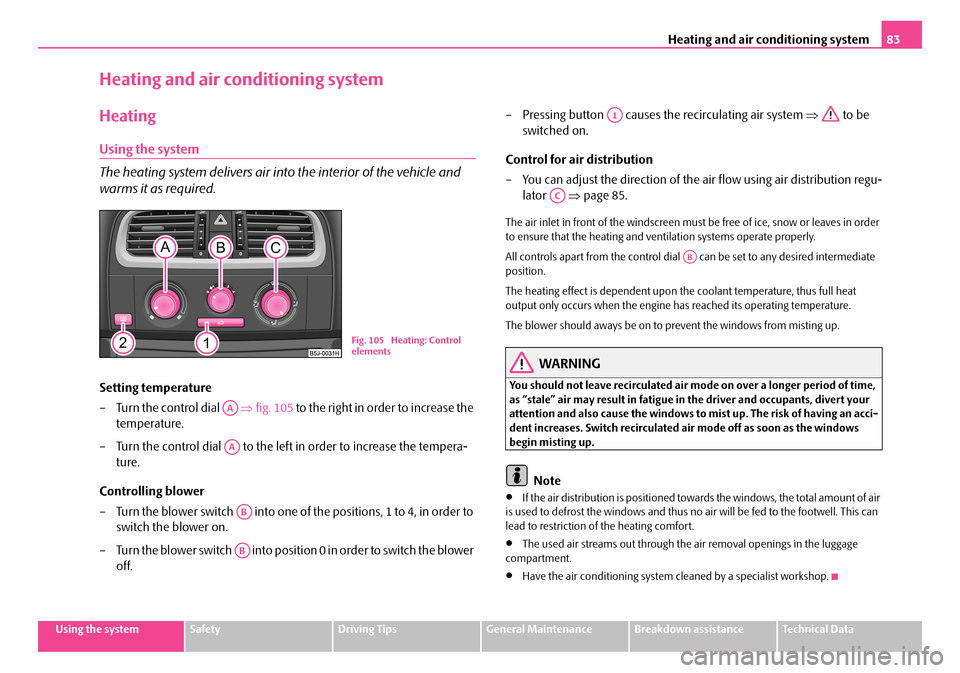
Heating and air conditioning system83
Using the systemSafetyDriving TipsGeneral MaintenanceBreakdown assistanceTechnical Data
Heating and air conditioning system
Heating
Using the system
The heating system delivers air into the interior of the vehicle and
warms it as required.
Setting temperature
ŌĆō Turn the control dial ŌćÆfig. 105 to the right in order to increase the
temperature.
ŌĆō Turn the control dial to the left in order to increase the tempera-
ture.
Controlling blower
ŌĆō Turn the blower switch into one of the positions, 1 to 4, in order to
switch the blower on.
ŌĆō Turn the blower switch into position 0 in order to switch the blower
off.
ŌĆō Pressing button causes the recirculating air system ŌćÆ to be
switched on.
Control for air distribution
ŌĆō You can adjust the direction of the air flow using air distribution regu-
lator ŌćÆpage 85.
The air inlet in front of the windscreen must be free of ice, snow or leaves in order to ensure that the heating and ventilation systems operate properly.
All controls apart from the control dial can be set to any desired intermediate position.
The heating effect is dependent upon the coolant temperature, thus full heat output only occurs when the engine has reached its operating temperature.
The blower should aways be on to prevent the windows from misting up.
WARNING
You should not leave recirculated air mode on over a longer period of time, as ŌĆ£staleŌĆØ air may result in fatigue in the driver and occupants, divert your attention and also cause the windows to mist up. The risk of having an acci-dent increases. Switch recirculated air mode off as soon as the windows begin misting up.
Note
ŌĆóIf the air distribution is positioned towards the windows, the total amount of air is used to defrost the windows and thus no air will be fed to the footwell. This can lead to restriction of the heating comfort.
ŌĆóThe used air streams out through the air removal openings in the luggage compartment.
ŌĆóHave the air conditioning system cleaned by a specialist workshop.
Fig. 105 Heating: Control elements
AA
AA
AB
AB
A1
AC
AB
NKO A05F 20.book Page 83 Wednesday, April 2, 2008 1:02 PM
Page 86 of 252
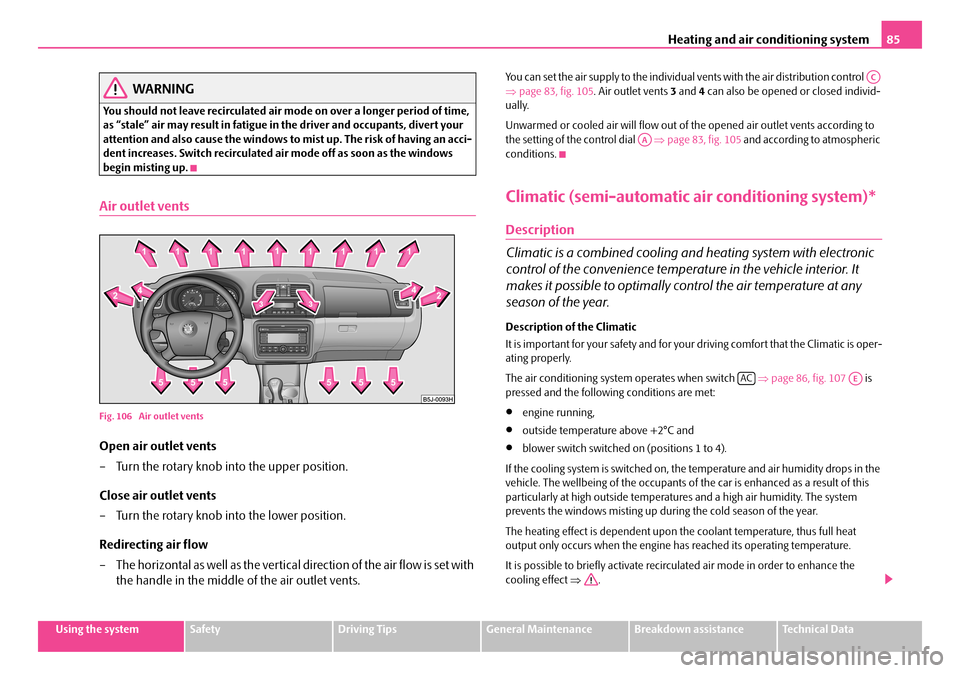
Heating and air conditioning system85
Using the systemSafetyDriving TipsGeneral MaintenanceBreakdown assistanceTechnical Data
WARNING
You should not leave recirculated air mode on over a longer period of time, as ŌĆ£staleŌĆØ air may result in fatigue in the driver and occupants, divert your attention and also cause the windows to mist up. The risk of having an acci-dent increases. Switch recirculated air mode off as soon as the windows begin misting up.
Air outlet vents
Fig. 106 Air outlet vents
Open air outlet vents
ŌĆō Turn the rotary knob into the upper position.
Close air outlet vents
ŌĆō Turn the rotary knob into the lower position.
Redirecting air flow
ŌĆō The horizontal as well as the vertical direction of the air flow is set with
the handle in the middle of the air outlet vents.
You can set the air supply to the individual vents with the air distribution control ŌćÆpage 83, fig. 105. Air outlet vents 3 and 4 can also be opened or closed individ-ually.
Unwarmed or cooled air will flow out of the opened air outlet vents according to the setting of the control dial ŌćÆpage 83, fig. 105 and according to atmospheric conditions.
Climatic (semi-automatic air conditioning system)*
Description
Climatic is a combined cooling and heating system with electronic
control of the convenience temperature in the vehicle interior. It
makes it possible to optimally control the air temperature at any
season of the year.
Description of the Climatic
It is important for your safety and for your driving comfort that the Climatic is oper-ating properly.
The air conditioning system operates when switch ŌćÆpage 86, fig. 107 is pressed and the following conditions are met:
ŌĆóengine running,
ŌĆóoutside temperature above +2┬░C and
ŌĆóblower switch switched on (positions 1 to 4).
If the cooling system is switched on, the temperature and air humidity drops in the vehicle. The wellbeing of the occupants of the car is enhanced as a result of this particularly at high outside temperatures and a high air humidity. The system prevents the windows misting up during the cold season of the year.
The heating effect is dependent upon the coolant temperature, thus full heat output only occurs when the engine has reached its operating temperature.
It is possible to briefly activate recirculated air mode in order to enhance the cooling effect ŌćÆ.
AC
AA
ACAE
NKO A05F 20.book Page 85 Wednesday, April 2, 2008 1:02 PM
Page 88 of 252
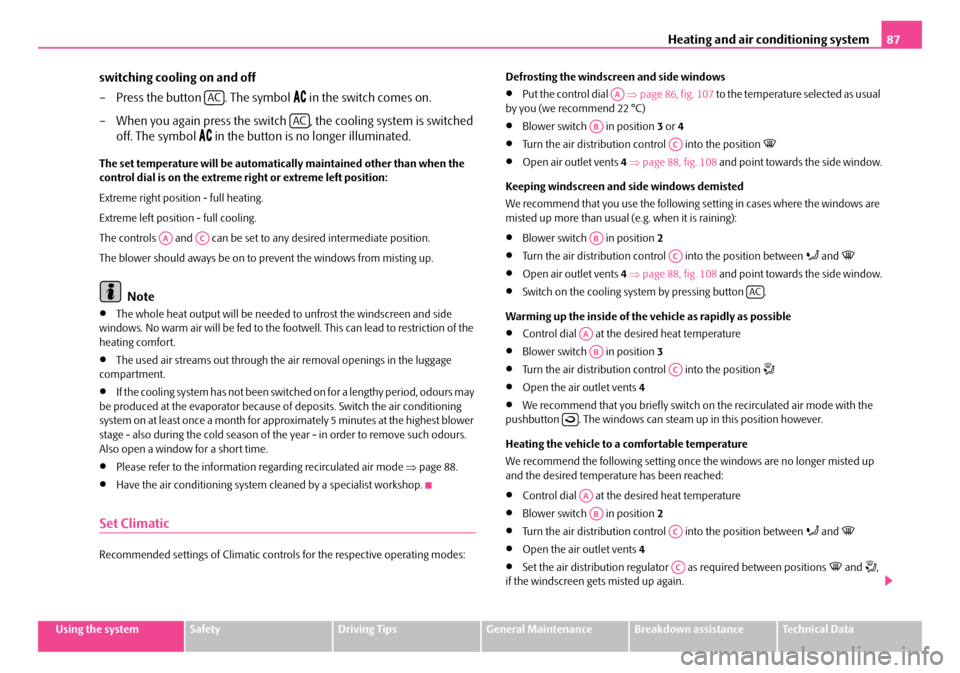
Heating and air conditioning system87
Using the systemSafetyDriving TipsGeneral MaintenanceBreakdown assistanceTechnical Data
switching cooling on and off
ŌĆō Press the button . The symbol ’üü’üā in the switch comes on.
ŌĆō When you again press the switch , the cooling system is switched
off. The symbol ’üü’üā in the button is no longer illuminated.
The set temperature will be automatically maintained other than when the control dial is on the extreme right or extreme left position:
Extreme right position - full heating.
Extreme left position - full cooling.
The controls and can be set to any desired intermediate position.
The blower should aways be on to prevent the windows from misting up.
Note
ŌĆóThe whole heat output will be needed to unfrost the windscreen and side windows. No warm air will be fed to the footwell. This can lead to restriction of the heating comfort.
ŌĆóThe used air streams out through the air removal openings in the luggage compartment.
ŌĆóIf the cooling system has not been switched on for a lengthy period, odours may be produced at the evaporator because of deposits. Switch the air conditioning system on at least once a month for approximately 5 minutes at the highest blower stage - also during the cold season of the year - in order to remove such odours. Also open a window for a short time.
ŌĆóPlease refer to the information regarding recirculated air mode ŌćÆpage 88.
ŌĆóHave the air conditioning system cleaned by a specialist workshop.
Set Climatic
Recommended settings of Climatic controls for the respective operating modes:
Defrosting the windscreen and side windows
ŌĆóPut the control dial ŌćÆpage 86, fig. 107 to the temperature selected as usual by you (we recommend 22 ┬░C)
ŌĆóBlower switch in position 3 or 4
ŌĆóTurn the air distribution control into the position ’ü£
ŌĆóOpen air outlet vents 4 ŌćÆpage 88, fig. 108 and point towards the side window.
Keeping windscreen and side windows demisted
We recommend that you use the following setting in cases where the windows are misted up more than usual (e.g. when it is raining):
ŌĆóBlower switch in position 2
ŌĆóTurn the air distribution control into the position between ’Ƭ and ’ü£
ŌĆóOpen air outlet vents 4 ŌćÆpage 88, fig. 108 and point towards the side window.
ŌĆóSwitch on the cooling system by pressing button .
Warming up the inside of the vehicle as rapidly as possible
ŌĆóControl dial at the desired heat temperature
ŌĆóBlower switch in position 3
ŌĆóTurn the air distribution control into the position ’üČ
ŌĆóOpen the air outlet vents 4
ŌĆóWe recommend that you briefly switch on the recirculated air mode with the pushbutton . The windows can steam up in this position however.
Heating the vehicle to a comfortable temperature
We recommend the following setting once the windows are no longer misted up and the desired temperature has been reached:
ŌĆóControl dial at the desired heat temperature
ŌĆóBlower switch in position 2
ŌĆóTurn the air distribution control into the position between ’Ƭ and ’ü£
ŌĆóOpen the air outlet vents 4
ŌĆóSet the air distribution regulator as required between positions ’ü£ and ’üČ, if the windscreen gets misted up again.
AC
AC
AAAC
AA
AB
AC
AB
AC
AC
AA
AB
AC
’ĆŁ
AA
AB
AC
AC
NKO A05F 20.book Page 87 Wednesday, April 2, 2008 1:02 PM
Page 90 of 252

Heating and air conditioning system89
Using the systemSafetyDriving TipsGeneral MaintenanceBreakdown assistanceTechnical Data
Close air outlet vents
ŌĆō Turn the rotary knob into the lower position.
Redirecting air flow
ŌĆō The horizontal as well as the vertical direction of the air flow is set with
the handle in the middle of the air outlet vents.
You can set the air supply to the individual vents with the air distribution control ŌćÆpage 86, fig. 107. Air outlet vents 3 and 4 can also be opened or closed individ-ually:
Unwarmed or cooled air will flow out of the air outlet vents according to the setting of control dial ŌćÆpage 86, fig. 107 and the atmospheric conditions.
Using the air conditioning system economically
The compressor on the Climatic uses power from the engine when in cooling mode which will effect the fuel consumption.
It recommended to open the windows or the doors of a vehicle for which the inte-rior has been strongly heated through the effect of direct sunlight in order to allow the heated air to escape.
The cooling system should not be switched on while travelling when the window is open.
The desired interior temperature can also be achieved without switching in the cooling system just by switching to fresh air mode.
For the sake of the environment
When you economize on fuel, you also reduce pollutant emissions.
Operational problems
If the cooling system does not operate at outside temperatures higher than +2 ┬░C, there is a problem in the system. The reasons for this may be:
ŌĆóThe fuse of the Climatic is defective. Check the fuse, replace it if necessary ŌćÆpage 213.
ŌĆóThe cooling system has switched off automatically for a short time because the coolant temperature of the engine is too hot ŌćÆpage 10.
If you are not able to rectify the operational problem yourself, or if the cooling capacity decreases, switch the cooling system off. Contact a specialist garage.
If there is a fault at the Climatronic, all symbols on the display flash after switching on the ignition for 15 seconds. Contact a specialist garage.
Climatronic (automatic air conditioning)*
Description
The Climatronic system is a combination of an automatic heating,
fresh air and cooling system which provides optimal comfort for the
occupants of the car.
The Climatronic maintains a constant temperature fully automatically, once it has been set. This is achieved by automatically varying the temperature of the outflowing air, the blower stages and the air distribution. The system also takes into account sunlight which eliminates the need to alter the settings manually. The automatic mode ŌćÆpage 91 ensures maximum wellbeing of the occupants at all times of the year.
Description of Climatronic system
The cooling operates only if the following conditions are met:
ŌĆóengine running,
ŌĆóoutside temperature above +2┬░C,
ŌĆóthe button is not pressed.
If the cooling system is switched on, the temperature and air humidity drops in the vehicle. The wellbeing of the occupants of the car is enhanced as a result of this particularly at high outside temperatures and a high air humidity. The system prevents the windows misting up during the cold season of the year.
AC
AA
ECON
NKO A05F 20.book Page 89 Wednesday, April 2, 2008 1:02 PM
Page 92 of 252

Heating and air conditioning system91
Using the systemSafetyDriving TipsGeneral MaintenanceBreakdown assistanceTechnical Data
Buttons / control dial
Setting the blower speed
The displays
Set blower speed
The outside temperature
Climatronic fault, have the vehicle inspected by a specialist garage
Air flow to the windows
Recirculated air mode
Air flow to the head, upper body and feet
Display of selected interior temperature, here: +20┬░C
Automatic mode
ECON mode
Buttons / control dial
Setting the interior temperature
Air flow to the windows
Automatic mode
Air flow in the footwell
Air flow to the upper body
Air flow to head
Button for switching off cooling system
Recirculated air mode
Note
The interior temperature sensor is located in the bottom part of the device. Do not glue or cover over the sensor, otherwise it could have an unfavourable effect on the Climatronic.
Automatic mode
The automatic mode is used in order to maintain a constant temper-
ature and to keep the windows in the interior of the car dry.
Switching automatic mode on
ŌĆō Set a temperature between +18 ┬░C and +29 ┬░C.
ŌĆō Move the air outlet vents 3 and 4 ŌćÆpage 93, fig. 110 so that the air
flow is directed slightly upwards.
ŌĆōPress the button , AUTO appears in the display.
The automatic mode is switched off by pressing the button for the air distribution or increasing or decreasing the blower speed. The temperature is nevertheless regulated.
ECON mode
The cooling system is switched off in the ECON mode - heating and
ventilation are regulated automatically.
Switching ECON mode on
ŌĆōPress the button , ECON appears in the display.
ŌĆō Set a temperature between +18 ┬░C and +29 ┬░C.
Recirculated air mode in ECON mode
ŌĆōPress the button , AUTO appears in the display.
ŌĆōPress the button , ECON appears in the display.
ECON mode operates only within the control temperature range from +18 ┬░C up to +29 ┬░C.
The ECON mode is switched off when pressing button or .
Please note that, in the ECON mode, the interior temperature cannot be lower than the outside temperature. The interior is not cooled and the air is not dehumidified.
A1
A2
A3
A4
A5
A6
A7
A8
A9
A10
A11
A12
A14
A15
A16
A17
A18
A19
A13
AUTO
ECON
’ĆŁ
ECON
’ü£’ĆŁ
NKO A05F 20.book Page 91 Wednesday, April 2, 2008 1:02 PM
Page 94 of 252

Heating and air conditioning system93
Using the systemSafetyDriving TipsGeneral MaintenanceBreakdown assistanceTechnical Data
ŌĆō Turn the control dial ŌćÆpage 90, fig. 109 to the left (reduce blower
speed) or right (increase blower speed).
Switch off the blowers, the Climatronic is switched off and in the display shows OFF.
The set blower speed is displayed next to the control dial when the respective number of warning lights come on.
WARNING
ŌĆóŌĆ£Stale airŌĆØ may result in fatigue in the driver and occupants, reduce attention levels and also cause the windows to mist up. The risk of having an accident increases.
ŌĆóDo not switch the Climatronic system off for longer than necessary.
ŌĆóSwitch the Climatronic system on as soon as the windows mist up.
Air outlet vents
Fig. 110 Air outlet vents
Open air outlet vents
ŌĆō Turn the rotary knob into the upper position.
Close air outlet vents
ŌĆō Turn the rotary knob into the lower position.
Redirecting air flow
ŌĆō The horizontal as well as the vertical direction of the air flow is set with
the handle in the middle of the air outlet vents.
You can control the air distribution to the air outlet vents via the buttons of the operating part of the Climatronic ŌćÆpage 90. Air outlet vents 3 and 4 ŌćÆfig. 110 can also be opened or closed individually.
A1
A1
NKO A05F 20.book Page 93 Wednesday, April 2, 2008 1:02 PM
Page 96 of 252
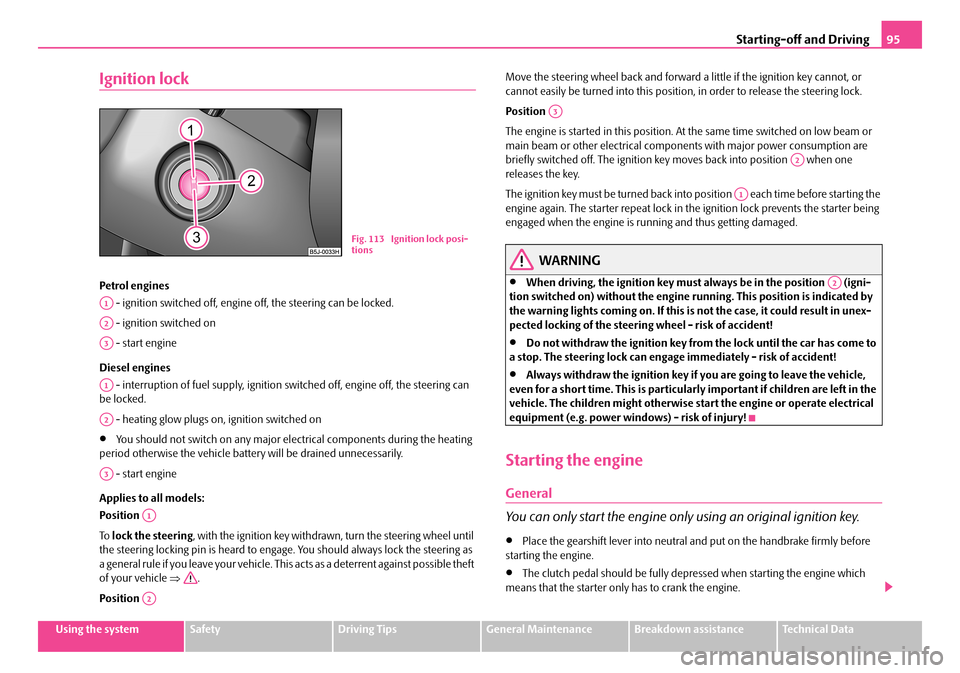
Starting-off and Driving95
Using the systemSafetyDriving TipsGeneral MaintenanceBreakdown assistanceTechnical Data
Ignition lock
Petrol engines
- ignition switched off, engine off, the steering can be locked.
- ignition switched on
- start engine
Diesel engines
- interruption of fuel supply, ignition switched off, engine off, the steering can be locked.
- heating glow plugs on, ignition switched on
ŌĆóYou should not switch on any major electrical components during the heating period otherwise the vehicle battery will be drained unnecessarily.
- start engine
Applies to all models:
Position
To lock the steering, with the ignition key withdrawn, turn the steering wheel until the steering locking pin is heard to engage. You should always lock the steering as a general rule if you leave your vehicle. This acts as a deterrent against possible theft of your vehicle ŌćÆ.
Position
Move the steering wheel back and forward a little if the ignition key cannot, or cannot easily be turned into this position, in order to release the steering lock.
Position
The engine is started in this position. At the same time switched on low beam or main beam or other electrical components with major power consumption are briefly switched off. The ignition key moves back into position when one releases the key.
The ignition key must be turned back into position each time before starting the engine again. The starter repeat lock in the ignition lock prevents the starter being engaged when the engine is running and thus getting damaged.
WARNING
ŌĆóWhen driving, the ignition key must always be in the position (igni-tion switched on) without the engine running. This position is indicated by the warning lights coming on. If this is not the case, it could result in unex-pected locking of the steering wheel - risk of accident!
ŌĆóDo not withdraw the ignition key from the lock until the car has come to a stop. The steering lock can engage immediately - risk of accident!
ŌĆóAlways withdraw the ignition key if you are going to leave the vehicle, even for a short time. This is particularly important if children are left in the vehicle. The children might otherwise start the engine or operate electrical equipment (e.g. power windows) - risk of injury!
Starting the engine
General
You can only start the engine only using an original ignition key.
ŌĆóPlace the gearshift lever into neutral and put on the handbrake firmly before starting the engine.
ŌĆóThe clutch pedal should be fully depressed when starting the engine which means that the starter only has to crank the engine.
Fig. 113 Ignition lock posi-tions
A1
A2
A3
A1
A2
A3
A1
A2
A3
A2
A1
A2
NKO A05F 20.book Page 95 Wednesday, April 2, 2008 1:02 PM
Page 98 of 252
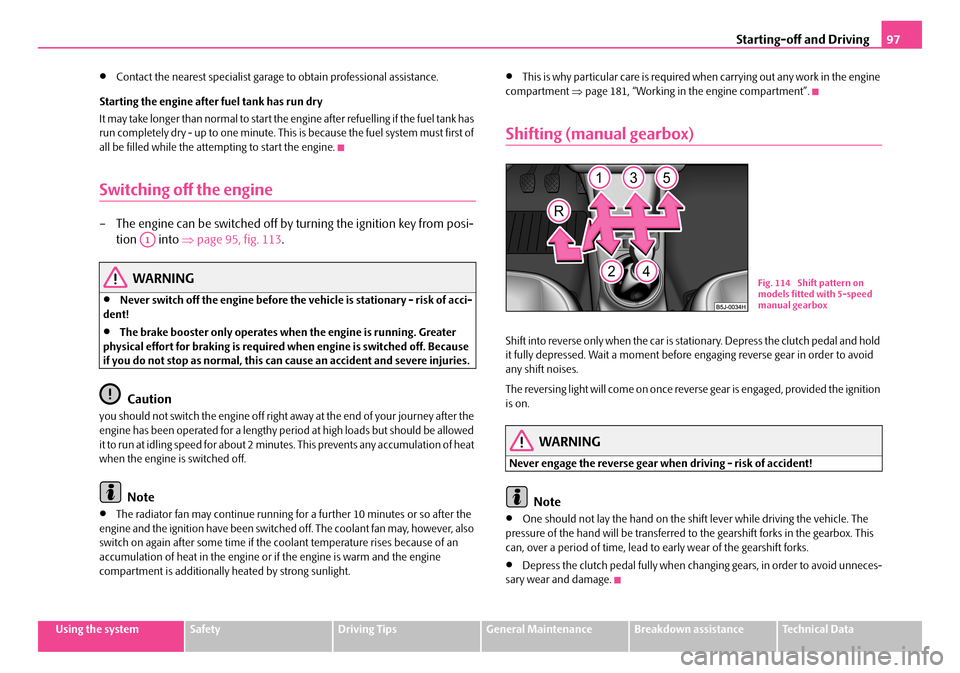
Starting-off and Driving97
Using the systemSafetyDriving TipsGeneral MaintenanceBreakdown assistanceTechnical Data
ŌĆóContact the nearest specialist garage to obtain professional assistance.
Starting the engine after fuel tank has run dry
It may take longer than normal to start the engine after refuelling if the fuel tank has run completely dry - up to one minute. This is because the fuel system must first of all be filled while the attempting to start the engine.
Switching off the engine
ŌĆō The engine can be switched off by turning the ignition key from posi-
tion into ŌćÆpage 95, fig. 113.
WARNING
ŌĆóNever switch off the engine before the vehicle is stationary - risk of acci-dent!
ŌĆóThe brake booster only operates when the engine is running. Greater physical effort for braking is required when engine is switched off. Because if you do not stop as normal, this can cause an accident and severe injuries.
Caution
you should not switch the engine off right away at the end of your journey after the engine has been operated for a lengthy period at high loads but should be allowed it to run at idling speed for about 2 minutes. This prevents any accumulation of heat when the engine is switched off.
Note
ŌĆóThe radiator fan may continue running for a further 10 minutes or so after the engine and the ignition have been switched off. The coolant fan may, however, also switch on again after some time if the coolant temperature rises because of an accumulation of heat in the engine or if the engine is warm and the engine compartment is additionally heated by strong sunlight.
ŌĆóThis is why particular care is required when carrying out any work in the engine compartment ŌćÆpage 181, ŌĆ£Working in the engine compartmentŌĆØ.
Shifting (manual gearbox)
Shift into reverse only when the car is stationary. Depress the clutch pedal and hold it fully depressed. Wait a moment before engaging reverse gear in order to avoid any shift noises.
The reversing light will come on once reverse gear is engaged, provided the ignition is on.
WARNING
Never engage the reverse gear when driving - risk of accident!
Note
ŌĆóOne should not lay the hand on the shift lever while driving the vehicle. The pressure of the hand will be transferred to the gearshift forks in the gearbox. This can, over a period of time, lead to early wear of the gearshift forks.
ŌĆóDepress the clutch pedal fully when changing gears, in order to avoid unneces-sary wear and damage.
A1
Fig. 114 Shift pattern on models fitted with 5-speed manual gearbox
NKO A05F 20.book Page 97 Wednesday, April 2, 2008 1:02 PM
Page 100 of 252
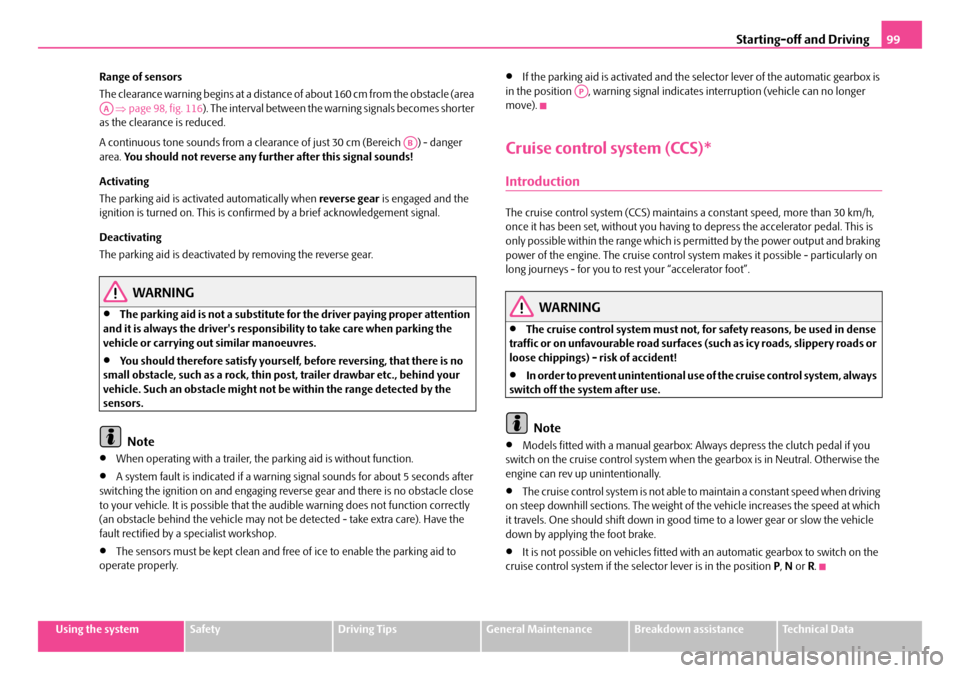
Starting-off and Driving99
Using the systemSafetyDriving TipsGeneral MaintenanceBreakdown assistanceTechnical Data
Range of sensors
The clearance warning begins at a distance of about 160 cm from the obstacle (area ŌćÆpage 98, fig. 116). The interval between the warning signals becomes shorter as the clearance is reduced.
A continuous tone sounds from a clearance of just 30 cm (Bereich ) - danger area. You should not reverse any further after this signal sounds!
Activating
The parking aid is activated automatically when reverse gear is engaged and the ignition is turned on. This is confirmed by a brief acknowledgement signal.
Deactivating
The parking aid is deactivated by removing the reverse gear.
WARNING
ŌĆóThe parking aid is not a substitute for the driver paying proper attention and it is always the driver's responsibility to take care when parking the vehicle or carrying out similar manoeuvres.
ŌĆóYou should therefore satisfy yourself, before reversing, that there is no small obstacle, such as a rock, thin post, trailer drawbar etc., behind your vehicle. Such an obstacle might not be within the range detected by the sensors.
Note
ŌĆóWhen operating with a trailer, the parking aid is without function.
ŌĆóA system fault is indicated if a warning signal sounds for about 5 seconds after switching the ignition on and engaging reverse gear and there is no obstacle close to your vehicle. It is possible that the audible warning does not function correctly (an obstacle behind the vehicle may not be detected - take extra care). Have the fault rectified by a specialist workshop.
ŌĆóThe sensors must be kept clean and free of ice to enable the parking aid to operate properly.
ŌĆóIf the parking aid is activated and the selector lever of the automatic gearbox is in the position , warning signal indicates interruption (vehicle can no longer move).
Cruise control system (CCS)*
Introduction
The cruise control system (CCS) maintains a constant speed, more than 30 km/h, once it has been set, without you having to depress the accelerator pedal. This is only possible within the range which is permitted by the power output and braking power of the engine. The cruise control system makes it possible - particularly on long journeys - for you to rest your ŌĆ£accelerator footŌĆØ.
WARNING
ŌĆóThe cruise control system must not, for safety reasons, be used in dense traffic or on unfavourable road surfaces (such as icy roads, slippery roads or loose chippings) - risk of accident!
ŌĆóIn order to prevent unintentional use of the cruise control system, always switch off the system after use.
Note
ŌĆóModels fitted with a manual gearbox: Always depress the clutch pedal if you switch on the cruise control system when the gearbox is in Neutral. Otherwise the engine can rev up unintentionally.
ŌĆóThe cruise control system is not able to maintain a constant speed when driving on steep downhill sections. The weight of the vehicle increases the speed at which it travels. One should shift down in good time to a lower gear or slow the vehicle down by applying the foot brake.
ŌĆóIt is not possible on vehicles fitted with an automatic gearbox to switch on the cruise control system if the selector lever is in the position P, N or R.
AA
AB
AP
NKO A05F 20.book Page 99 Wednesday, April 2, 2008 1:02 PM
Page 102 of 252
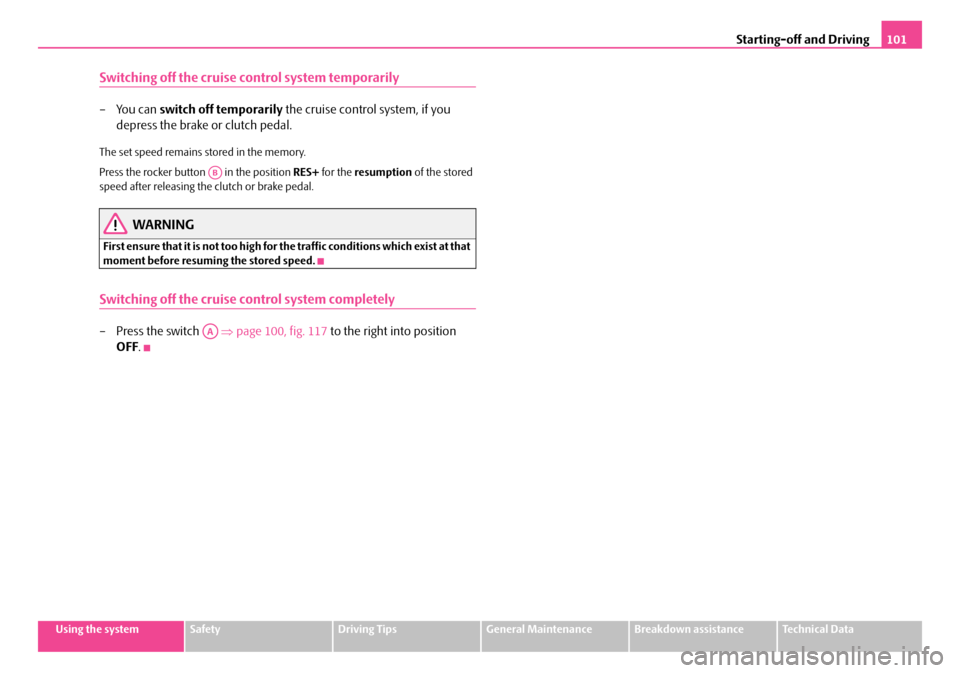
Starting-off and Driving101
Using the systemSafetyDriving TipsGeneral MaintenanceBreakdown assistanceTechnical Data
Switching off the cruise control system temporarily
ŌĆōYou can switch off temporarily the cruise control system, if you
depress the brake or clutch pedal.
The set speed remains stored in the memory.
Press the rocker button in the position RES+ for the resumption of the stored speed after releasing the clutch or brake pedal.
WARNING
First ensure that it is not too high for the traffic conditions which exist at that moment before resuming the stored speed.
Switching off the cruise control system completely
ŌĆō Press the switch ŌćÆpage 100, fig. 117 to the right into position
OFF.
AB
AA
NKO A05F 20.book Page 101 Wednesday, April 2, 2008 1:02 PM